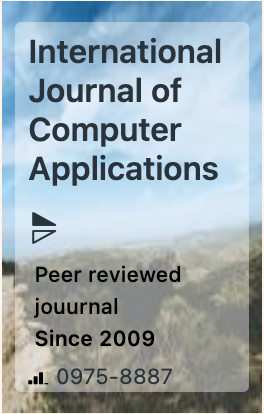The week's pick
Random Articles
Reseach Article
MDFBA: A Mobile Agent and Device Fingerprint-based Authentication Scheme for Enhanced Android Security
| International Journal of Computer Applications |
| Foundation of Computer Science (FCS), NY, USA |
| Volume 187 - Number 7 |
| Year of Publication: 2025 |
| Authors: Umesh Kumar |
 10.5120/ijca2025924953
10.5120/ijca2025924953
|
Umesh Kumar . MDFBA: A Mobile Agent and Device Fingerprint-based Authentication Scheme for Enhanced Android Security. International Journal of Computer Applications. 187, 7 ( May 2025), 6-19. DOI=10.5120/ijca2025924953
Abstract
Modern digital ecosystems, from enterprise infrastructures to Internet of Things networks, depend heavily on authentication mechanisms. Based on important performance and security criterias, such as authentication accuracy, latency, scalability, security resilience, computational overhead, and network traffic generation, this study assesses three authentication models: OAuth, Zero Trust, and a Mobile Agent and Device Fingerprint-Based Authentication Scheme (MDFBA). Using mobile agents and signature-based authentication, the implemented algorithm ensures low latency (1.23 ms) and minimum traffic overhead (~5,000 bytes for 100 nodes), making it ideal for resource-constrained situations. OAuth provides excellent scalability and interoperability and is commonly used for web authentication and Single Sign-On (SSO). However, it has middling authentication accuracy (~85%) due to security flaws including token theft and phishing attempts. In high-performance networks, its latency (72.8 ms) and traffic generation (~15,000 bytes per 100 nodes) pose scalability issues. The most secure of the three models, Zero Trust, uses dynamic policy enforcement and continuous verification, which makes it extremely resistant to replay, credential theft, and man-in-the-middle attacks. This security feature is limited in low-resource situations due to its high latency (~166.2 ms), high processing needs, and substantial network traffic (~40,000 bytes per 100 nodes). Performance and security are traded off, according to a quantitative examination conducted across different node scales. Zero Trust adds significant processing and network overheads, but it guarantees better security. On the other hand, the Implemented Algorithm balances security and efficiency, making it appropriate for Internet of Things applications, whereas OAuth offers scalability but is still susceptible to attack vectors. This study emphasizes the urgent need for hybrid authentication strategies that combine the scalability of OAuth, the security robustness of Zero Trust, and optimizations based on mobile agents. Future research will examine blockchain-based decentralized identity verification, AI-powered adaptive authentication, and quantum-resistant cryptographic improvements.
References
- U. Kumar and S. Gambhir, "Device fingerprint and mobile agent-based authentication technique in wireless networks," Int. J. Fut. Gen. Comm. Netw., vol. 11, no. 3, pp. 33–48, 2018.
- Statista, "Number of IoT connected devices worldwide," 2024.[Online].Available: https://www.statista.com/statistics/1183457/iot-connected-devices-worldwide/
- U. Kumar and S. Gambhir, “Device Fingerprint and Mobile Agent based Authentication Technique in Wireless Networks,” *Int. J. Future Gener. Commun. Netw.*, vol. 11, no. 3, pp. 33–48, 2018.
- M. El Fissaoui, A. Beni-hssane, and M. Saadi, "Multi-mobile agent itinerary planning-based energy and fault aware data aggregation in wireless sensor networks," EURASIP J. Wireless Commun. Netw., 2018.
- X. Wang, M. Chen, T. Kwon, and H. C. Chao, "Multiple mobile agents’ itinerary planning in wireless sensor networks: Survey and evaluation," IET Commun., vol. 5, pp. 1769–1776, 2011.
- H. Q. Qadori, Z. A. Zulkarnain, Z. M. Hanapi, and S. Subramaniam, "Multi-mobile agent itinerary planning algorithms for data gathering in wireless sensor networks: A review paper," Int. J. Distrib. Sensor Netw., vol. 13, no. 2, pp. 1–13, 2017.
- T. Zhao, X. Wang, and S. Mao, "Cross-domain, scalable, and interpretable RF device fingerprinting," in Proc. IEEE INFOCOM, 2024.
- P. M. Sánchez et al., "Adversarial attacks and defenses on ML-and hardware-based IoT device fingerprinting and identification," Future Gener. Comput. Syst., vol. 152, pp. 30–42, 2024.
- R. Li et al., "DeviceRadar: Online IoT device fingerprinting in ISPs using programmable switches," IEEE/ACM Trans. Netw., 2024.
- K. Heid and J. Heider, "Haven't we met before?-Detecting device fingerprinting activity on Android apps," in Proc. Eur. Interdiscip. Cybersecurity Conf., 2024.
- Z. Lin et al., "A life cycle management architecture for power equipment based on device fingerprinting," in Proc. IEEE Int. Symp. Auton. Syst. (ISAS), 2024.
- S. Abbas et al., "Radio frequency fingerprinting techniques for device identification: A survey," Int. J. Inf. Secur., vol. 23, no. 2, pp. 1389–1427, 2024.
- Z. Lv et al., "Research on distributed PV network terminal identification technology based on device fingerprint generation," in Proc. 3rd Int. Conf. Comput. Technol., Inf. Eng., Electron. Mater. (CTIEEM), vol. 12987, SPIE, 2024.
- Z. Xi et al., "Device identity recognition based on an adaptive environment for intrinsic security fingerprints," Electronics, vol. 13, no. 3, p. 656, 2024.
- D. Zhang et al., "DevPF: Device identification through passive fingerprints in IoT," in Proc. IEEE Int. Symp. Auton. Syst. (ISAS), 2024.
- V. Kohli, M. N. Aman, and B. Sikdar, "An intelligent fingerprinting technique for low-power embedded IoT devices," IEEE Trans. Artif. Intell., 2024.
- V. Kumar and K. Paul, "Device fingerprinting for cyber-physical systems: A survey," ACM Comput. Surv., vol. 55, no. 14s, pp. 1–41, 2023.
- N. Basha et al., "Channel-resilient deep-learning-driven device fingerprinting through multiple data streams," IEEE Open J. Commun. Soc., vol. 4, pp. 118–133, 2023.
- H. Cui et al., "Trust assessment for mobile crowdsensing via device fingerprinting," ISA Trans., vol. 141, pp. 93–102, 2023.
- Y. Sang et al., "Toward IoT device fingerprinting from proprietary protocol traffic via key-blocks aware approach," Comput. Secur., vol. 131, p. 103145, 2023.
- R. R. Chowdhury and P. E. Abas, "A survey on device fingerprinting approach for resource-constraint IoT devices: Comparative study and research challenges," Internet Things, vol. 20, p. 100632, 2022.
- S. Aneja et al., "Device fingerprinting using deep convolutional neural networks," Int. J. Commun. Netw. Distrib. Syst., vol. 28, no. 2, pp. 171–198, 2022.
- J. V. Monaco, "Device fingerprinting with peripheral timestamps," in Proc. IEEE Symp. Secur. Privacy (SP), 2022.
- B. Hamdaoui and A. Elmaghbub, "Deep-learning-based device fingerprinting for increased LoRa-IoT security: Sensitivity to network deployment changes," IEEE Netw., vol. 36, no. 3, pp. 204–210, 2022.
- S. Wan et al., "DevTag: A benchmark for fingerprinting IoT devices," IEEE Internet Things J., vol. 10, no. 7, pp. 6388–6399, 2022.
- Z. Ren, P. Ren, and T. Zhang, "Deep RF device fingerprinting by semi-supervised learning with meta pseudo time-frequency labels," in Proc. IEEE Wireless Commun. Netw. Conf. (WCNC), 2022.
Index Terms
Keywords

